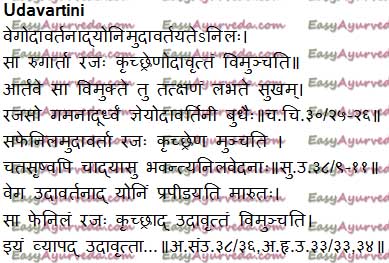Udavartini – Causes, Pathogenesis, Symptoms, Treatment
By Dr Raghuram Y.S. MD (Ay) & Dr Manasa, B.A.M.S
Udavartini is one among the 20 gynaecological disorders. It is caused due to aggravated apana vata which throws the menstrual blood in an upward direction causing painful menstruation. It is called by the name Udavrutta by both Vagbhatas. In Madhava Nidana treatise, the same condition is named as Udavarta. Read – Gynecological Disorders Causes, Types As Per Ayurveda
Table of Contents
Causes
Causative Factors of Udavarthini
Vega udavarta – movement of natural urges for flatus, feces, urine etc in a reverse / upward movement (other than the normal course of movement) Read – Vega Dharana: Suppression of urges, types, symptoms, and management
Pathology, symptoms
Pathogenesis of Udavartini
When the natural urges like that for flatus etc moves in a reverse direction / upward course, the apana vata gets aggravated. This aggravated vata moving in reverse / upward direction fills up the vagina and uterus, contaminates them and causes abnormalities i.e. painful conditions.
Signs and Symptoms of Udavartini
- Saa rugarta rajah krichchrena udavruttam vimunchati – the uterus seized with severe pain caused by vitiated vata, initially throws the menstrual blood in an upward direction and later discharges it with great difficulty
- Aartave saa vimukte tu tat kshanam labhate sukham – once the menstrual blood is discharged, the woman feels relieved
- Sa phena rajah – frothy menstruation (Sushruta)
- Anila vedanah – other painful conditions of vitiated vata, like body ache, malaise etc. (Sushruta)
- Baddha raktam – discharge of clotted blood (Indu, commentator of Ashtanga Hridayam)
- Phenila raja kruchchrena munchati, kaphena evam artavam – discharge of frothy, menstrual blood or menstrual blood associated with kapha, with difficulty
Read – Physiology Of Menstruation, Menstrual Cycle – Ayurvedic Perspective
Since in this condition, the menstrual blood moves in reverse direction it is called udavartini i.e. that which moves upwards. Madhukosha commentary explains the all around movement of vayu as the cause of pain in udavartini.
Sanskrit verse

Modern correlation
Udavartini gynaecological disorder seems to resemble all forms of dysmenorrhea. Read – Menstrual Pain, Painful Periods – Natural Ayurvedic Herbal Home Remedies
Spasmodic dysmenorrhea – Master Charaka tells that the woman feels immediately relieved from all painful conditions once the menstrual blood gets discharged. This explanation resembles the clinical picture of true / spasmodic dysmenorrhea. The condition of the menstrual blood moving upwards as explained by Charaka in the context of Udavartini appears due to hypertonicity or spasm of isthmus and internal os of uterus.
Discharge of clotted blood mentioned by commentator Indu, seems to be a description of specific form of spasmodic dysmenorrhea with discharge of clots of blood. Read – Heavy Periods, Menstrual Bleeding: Ayurvedic Treatment
Irregular / incoordinate myometrial contractions – the explanation given in Madhukosha commentary on Madhava Nidana which explains all around movement of vayu causing pain in Udavarta seems to be an explanation of irregular or incoordinate contractions of all the muscle fibres of uterus as happens in dysmenorrhea.
Membranous dysmenorrhea – Yogaratnakara treatise explains discharge of menstrual blood associated with kapha. If kapha can be taken as mucous membrane or endometrium, udavartini can be correlated to another form of dysmenorrhea i.e. membranous dysmenorrhea. Read – Vatala Yoni Vyapad – Causes, Symptoms, Treatment
Treatment
Treatment of Udavartini gynecological disorder
Snehana – oleation with Trivrit sneha i.e. mixture of ghee, oil and muscle fat
Mamsarasa – use of meat soup of animals and birds living in forests, marshy lands and water
Dashamula ksheera pana – milk medicated with dashamula should be given to drink
Dashamula ksheera basti – enema should be given with milk processed with dashamula
Anuvasana vasti – unctuous enema given with traivruta sneha
Uttara vasti – uterine / vaginal enema given with traivruta sneha
Vatahara krama – all measures capable of mitigating the vitiated vata should be adopted
Utkarika – poultice prepared with barley, wheat, yeast, Saussurea lappa, dill seeds, Sida cordifolia, Callicarpa macrophylla and Ipomea reniformis should be done, introduced inside the vagina
Ksheera sweda – sudation with hot milk
Dashamula-trivrut siddha sneha – fats i.e. ghee or oil medicated with dashamula and Operculina turpethum should be administered either for oral consumption or enema. This medicament shall be used to administer both, unctuous enema and also vaginal / uterine enema.
Click to Consult Dr Raghuram Y.S. MD (Ayu) – Email / Skype









